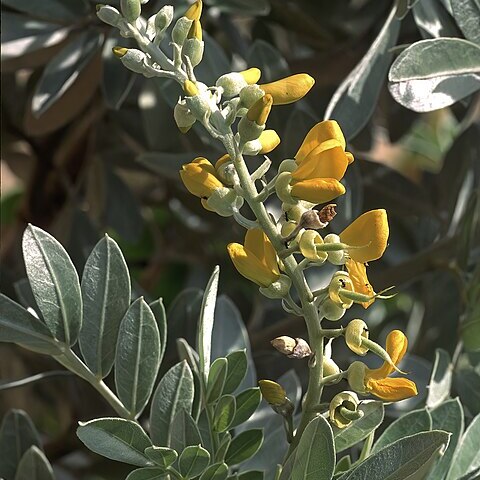Shrub 1-2 m high. Young branches, leaves, inflorescences and calyces densely whitish to silvery or golden pubescent, the calyces and both surfaces of the leaflets strongly sericeous. Leaves (rachis and petiole) 7-12(16) cm long, with (3)5-7(8) pairs of leaflets; lateral leaflets 1.8-4(5) x 0.7-1.5(2) cm, elliptic to obovate or oblanceolate, cuneate and slightly asymmetrical at the base, obtuse to subacute at the apex; terminal leaflet 1.5-2 times as long as the lateral ones, cuneate and equal at the base. Flowers in terminal many-flowered racemes up to 25 cm long; bracts up to 14 mm long, narrowly triangular to linear, often persistent, sometimes fused with base of pedicel; pedicels 5-12 mm long; bracteoles apparently absent. Calyx 4-6 mm long, campanulate, with 5 shallow teeth up to 1 mm long. Petals yellow; standard 17-22 x 15-18 mm, the limb suborbicular, cordate, the claw ± distinct; wings and keel petals slightly shorter than the standard. Ovary densely appressed-pubescent. Pods moniliform, with 1-3(5) seeds developing. Seeds 8-9 mm long, subglobose, brownish.
Leaves (rachis and petiole) 7–12(16) cm long, with (3)5–7(8) pairs of leaflets; lateral leaflets 1.8–4(5) × 0.7–1.5(2) cm, elliptic to obovate or oblanceolate, cuneate and slightly asymmetrical at the base, obtuse to subacute at the apex; terminal leaflet 1.5–2 times as long as the lateral ones, cuneate and equal at the base.
Flowers in terminal many-flowered racemes up to 25 cm long; bracts up to 14 mm long, narrowly triangular to linear, often persistent, sometimes fused with base of pedicel; pedicels 5–12 mm long; bracteoles apparently absent.
Young branches, leaves, inflorescences and calyces densely whitish to silvery or golden pubescent, the calyces and both surfaces of the leaflets strongly sericeous.
Petals yellow; standard 17–22 × 15–18 mm, the limb suborbicular, cordate, the claw ± distinct; wings and keel petals slightly shorter than the standard.
Calyx 4–6 mm long, campanulate, with 5 shallow teeth up to 1 mm long.
Pods moniliform, with 1–3(5) seeds developing.
Seeds 8–9 mm long, subglobose, brownish.
Ovary densely appressed-pubescent.
Shrub 1–2 m high.


